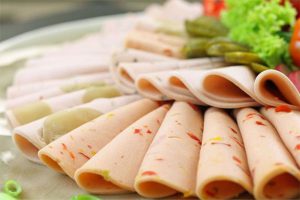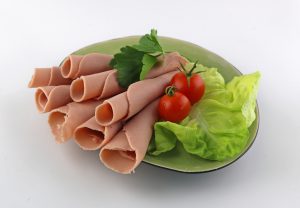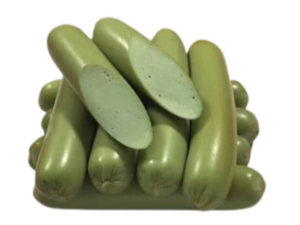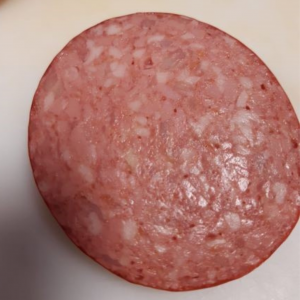Mixing meat for sausages
Mixing meat by hand also raises its temperature and should be done quickly to extend life of sausages. It takes roughly about 5 minutes to thoroughly mix 10 lbs. of meat. The ingredients may be premixed with chilly water in a blender, and then poured over the minced meat. The water helps to evenly distribute the ingredients and it also helps soften the mass during stuffing. We can easily add 1 cup of cold water to 5 lbs. of meat because it is going to evaporate during smoking anyhow. A rule of thumb is about 8% of water in relation to the weight of the meat. It only takes 5 minutes to mix 5 – 10 lbs of meat by hand. The time is important because fat specks start to melt at 95-104° F (35-40° C). We want to prevent this smearing to keep the sausage texture looking great. The temperature of the sausage mix should be between 0-5º C (32-40º F). If this temperature increases, the sausage mix should be cooled down in a refrigerator before proceeding to the stuffing step.
If the meat/fat mixture is not mixed adequately (then the salt/myosin reaction will be minimal and the water holding capacity and the meat binding capacities will be reduced. Apply some force when mixing, kneading might be a good word for it. This will help to extract proteins which will combine with salt and water and will create a sticky meat mass. This will hold meat particles together and will result in a good texture.
If the meat was previously cured, then the salt, nitrite, and sugar was already added to it. Now we have to add the remaining spices. They should be mixed with chilly water in a blender, and then poured over the minced meat. The water helps to evenly distribute the ingredients and it also helps soften it during stuffing. We can easily add 1 cup of cold water to 5 lbs of meat because it is going to evaporate during smoking anyway. Water should not be added to uncooked sausages which will be cold smoked, slow fermented or air dried.
When mixing meat with ingredients, it is best to follow this sequence:
- Minced meats, starter culture, nitrite/nitrate, spices.
- Minced fat.
- Salt.
There are some people that like to add spices to meat during the grinding step. Then they will mix it again. Some do not mix at all but grind meat through a big plate 3/4” – 1”, then add spices to ground meat and regrind it again through a 1/8” plate. Some say that placing salt in a grinder has a detrimental effect on a cutting knife and that it should be avoided. We believe that the easiest procedure for someone using a manual grinder is to grind the meat first and then mix it well with all ingredients.
Mixing introduces spices and flavourings into the previously minced meat. Home based sausage makers use a grinder to mince the meat which is then mixed by hand with other ingredients. The mixer is necessary when over 50 lbs. of sausage is produced as the task is physically demanding. There are small manually cranked mixers designed for a hobbyist and they will accommodate 25-50 lbs. of meat. Keep in mind that for limited home production a small mixer has some short comings. It must be:
- washed before use.
- washed in hot water after the use.
- stored somewhere.
It makes little sense to go into all this trouble to mix 5 lbs. of minced sausage mass when the same task can be accomplished in 5 minutes using hands and any suitable container. The meat should be placed in a big container to facilitate mixing it by hand. Like everything else, the container should be made of stainless steel, stone, or food grade plastic. Remember to taste your sausage now, before you stuff it, since you still have time to implement any changes. Make a tiny hamburger and fry it, it will take only a minute or two.
Mixing meat for sausages
Mixing meat with spices
If you are a fit person mixing of 50 lbs of meat should not present a problem.
There are small hand cranked mixers that can mix 20 – 50 lbs at a time. However, it is easy to mix 20 lbs of meat by hand the way we have been kneading dough for centuries.
Inside view of a 50 lb capacity manually operated meat mixer. Photo courtesy Sausage Maker, Buffalo, NY.
110 lb and 220 lb capacity mixers by Koch Equipment, Kansas City, MO
Emulsification
Understanding emulsions is important for making emulsified products such as hot dogs, frankfurters, bologna or liver sausages. During the grinding process fat cells become ruptured and the free fat is released. Fat does not dissolve in water or mix with it well. The purpose of emulsion is to bond free fat, meat and water together so they will not become separated. When fat comes out of emulsion it will be lost during cooking which amounts to a higher cooking loss. Emulsions can be of different types:
1. Natural meat emulsion.
This is a natural emulsion where meat must form a matrix to hold the fat. The leaner the meat the stronger matrix will be created. This matrix will hold water as well and will give a sausage its proper texture. Meat proteins are needed not only for their nutritional value but for their contribution towards emulsification and binding of meat products. Lean meat contains myofibrillar and sarcoplasmic proteins which are of high quality. Its emulsification value and binding properties are excellent.
- Pork rind emulsion. Pork skins are precooked for about 1.5 hours in hot simmering water and then chopped in a bowl cutter or food processor when still warm. About 1/3 of water, 1/3 pork skins and 1/3 back fat are combined to create emulsion. Such emulsion must be used quickly or cooled down and frozen for later use.
- Liver emulsion. Liver contains the natural emulsifying agent and around 30% is added when making liver sausages.
2. Caseinate (type of milk protein) and soy-based emulsion.
A typical caseinate based emulsion: 5 parts waters: 5 parts fat: 1 part caseinate. A typical soy isolates-based emulsion: 5 parts water: 5 parts fat: 1 part soya isolate. When less than lean meats are used, the binding will still take place providing enough exudate has formed. It may be further enhanced by lightly sprinkling meat surfaces with powdered gelatine. In addition a variety of materials may be used to enhance binding:
- Soy protein isolate.
- Soy protein concentrate.
- Non-fat milk powder.
- Caseinate (milk protein).
- Carrageenan – comes from algae or seaweed.
- Egg white.
More information on emulsions can be found in emulsified sausages
Machines for mixing meat and emulsification
When meat is mixed on an industrial scale, it is often done using tumblers and massagers.
Tumblers
Originally whole cuts of meat were either dry cured or immersed in brine. This required an investment in time and storage space. Today the majority of meats are injected with a solution of salt, nitrite, phosphates, sodium erythorbate and other ingredients and flavours. The operation is performed by a bank of about 30 needles which inject a solution under pressure into the meat. There is a limit to how many needles can be inserted as this procedure creates holes and affects the internal structure of the meat.
To evenly distribute the injected solution inside, the tumblers come into play. They offer the following advantages:
- Curing solution is distributed evenly inside of the meat.
- Curing times are greatly reduced.
- Mechanical action leads to stronger extraction of meat proteins and more exudate which helps in binding meat cuts together.
The primary purpose of tumbling these products is the optimal protein extraction which will allow individual pieces of meat to stick together during the cooking process.
The tumbler is a horizontal unit with a rotating drum. All tumblers employ a similar principle of operation: a set of paddles rotate inside of a tank moving meat pieces around. The meat pieces bounce around its moving walls providing better brine distribution inside of the meat.
Small products (below 2.5 inches in diameter) can be marinated and tumbled within minutes. Large (2.5 inches or larger) products can be marinated using a combination of injection and tumbling. Large whole muscle meats are normally injected with brine. Curing solution is distributed evenly inside of the meat.
There are units that operate under a vacuum that further improve the results. Through the use of vacuum tumbling, meat, poultry, fish, and seafood processors can produce ready to cook, value added products while reducing labour content and increasing product yields. Vacuum tumbling offers improvements to product sliceability, cure colour, and overall product juiciness and tenderness which results in higher profitability.
Due to renewed public interest in making quality products at home, smaller tumblers (8 and 15 lbs.) are carried by distributors of sausage making equipment and supplies.
Tumbler operation. A good tumbler must have a diameter of at least 3 feet, otherwise there is minor impact to falling meat pieces.
Koch LT-60 Vacuum tumbler, 1000 lbs. capacity. Photo courtesy Koch Equipment, Kansas City, MO.
The tumbler is a machine with a rotating drum. The meat pieces bounce around its moving walls providing better brine distribution inside of the meat. Tumblers normally are horizontal units where meats are struck by the paddles, fall down and are moved up again by the rotating paddles. A tumbler resembles a cloth dryer which moves wet clothing around by means of a rotating drum with paddles. Through the use of vacuum tumbling, meat, poultry, fish, and seafood processors can produce ready to cook, value added products while reducing labour content and increasing product yields. Vacuum tumbling offers improvements to product sliceability, cure colour, and overall product juiciness and tenderness which results in higher profitability.
Small products (below 2.5 inches in diameter) can be marinated and tumbled within minutes. Large (2.5 inches or larger) products can be marinated using a combination of injection and tumbling. Large whole muscle meats are normally injected with brine.
The primary purpose of tumbling these products is the optimal protein extraction which will allow individual pieces of meat to stick together during the cooking process. Due to renewed public interest in making quality products at home, smaller tumblers (8 and 15 lbs.) are carried by distributors of sausage making equipment and supplies.
Massagers
Massagers generally are vertical units and offer more delicate action than tumblers. Meat pieces rub against each other or the surface wall of the massager without loss of contact. Although the actual massaging or tumbling time is only about 1-3 hours, this action is continuously interrupted, and meats are allowed to rest. The process generally continues for about 24 hours at low temperatures. The machines are normally loaded 1/2 – 2/3 capacity. Due to their gentler mode of operation, massagers need more time than tumblers to perform the same task.
Benefits of massagers
- Improved product quality (juicier, more tender, and flavourful).
- Increased profit margins through the delivery of ready-to-cook, value-added products.
- Increased productivity through reduced handling/processing time.
Massager.
Koch equipment stainless steel Magnum Series 6000 massager with 6000-liters capacity.
The machine comes standard with cooling and is equipped with a uniquely designed baffle that rotates and slides the product throughout the drum during processing. This results in the product remaining against the walls and baffles of the drum versus the actual tumbling delivered by competitor models. The advantage is a gentler massaging action while extracting protein in a highly efficient manner under constant vacuum.





